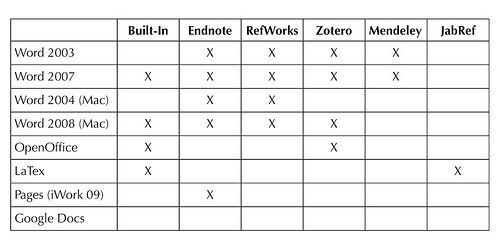Most of us find, store and sometimes read scientific papers electronically. Although abstracts and full-text papers are usually available as web pages in HTML format, PDF is clearly the preferred format for storing and printing papers. But publishing scientific papers in electronic form obviously requires more than providing the content in HTML or PDF format.
Front Matter
Reference managers are essential tools to read and write scholarly papers. In the last few years we have seen both a number of new reference managers (most of them web-based), but also a trend for the established reference managers to gain social networking features. More choice is great, but it also creates confusion about the right tool to use.
Scientific papers are submitted to a journal as word processor files, usually in Microsoft Word format. After the paper is accepted for publication, the journal takes the manuscript and translates the text into a format that is better suited for publication online and/or in print. XML and the NLM DTD – a set of XML schema modules – have evolved as the standard data format for this purpose.

Richard Grant, who needs no introduction here on Nature Network, has just moved to London to start a new job as information architect for Faculty of 1000. I took this opportunity to ask Richard a few questions not only about Faculty of 1000, but also about his role in the company and future plans for the service that they have in mind.1. Can you describe what Faculty of 1000 is and does?
I've recently asked a few questions about author identifiers for scientists. Here are the results (based on 48 responses). The results are also available as .xls file.
Now that we have a number of online reference managers to choose from, I thought it would be interesting to look at their popularity – both in absolute numbers of visitors and the in changes during the last 12 months. Online tools such as Compete allow everybody to do just that, and their basic functions are free to use.
The scientific articles we write are uniquely identified by Digital Object Identifiers (DOI). Many people believe that we also need unique identifiers for the authors of those articles. Some of the arguments why author identifiers could be very helpful are found in this interview with Geoffrey Bilder, this Researcher Identification Primer, and this FriendFeed discussion.

A recent Nature News article by Geoff Brumfiel (Science journalism: Supplanting the old media?) has stirred up many interesting discussions about the relationship of science blogging and traditional science journalism. Good starting places to follow these discussions (and engage in them) are Technorati, Nature.com Blogs and FriendFeed. Science blogging extends, but also threatens traditional science journalism.
Practically all scientific journals now use web-based systems for paper submissions and peer review. This saves the authors a lot of time compared to paper submissions by postal mail (until 15 years ago) or email (until 5 years ago). Unfortunately the submission process is still far from perfect and requires authors to spend many hours formatting manuscripts, references and images instead of focusing on the scientific content.

Citations of the relevant literature are an essential feature of scientific papers. Reference Manager software helps adding these citations and creating a bibliography. Are there differences in how reference managers work together with your word processor of choice?Support for your favorite word processor Support for word processors other than Microsoft Word is spotty.

18 April 2009: I've updated the chart and added 2collab, the “Read” category, sharing of PDF files, and the Mendeley bookmarklet and full-text search. 15 July 2009: I've updated the chart to indicate that Mendeley and L abmeeting have integrated PDF viewers and that 2collab can search Scopus. 20 July 2009: I've added the offline version of RefWorks for Windows, EndNote OpenOffice plugin, and